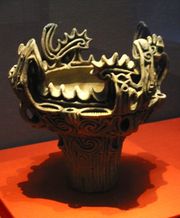Jomon
From BME Encyclopedia
Jomon is the earliest period known of traditional Japanese tattooing (10,000 B. C. ~ 300 B. C.). Jomon means "pattern of rope." Many ceramic pots with markings of rope were found in that period. Clay figurines produced in this period are called dogu. Scholars consider that some dogus show tattoo-like markings on their faces and bodies. The oldest dogus whose faces have a depiction of tattooing were found near Osaka in 1977.
The people on the Japanese islands during the Jomon era may be the distant predecessors of the Ainu.
